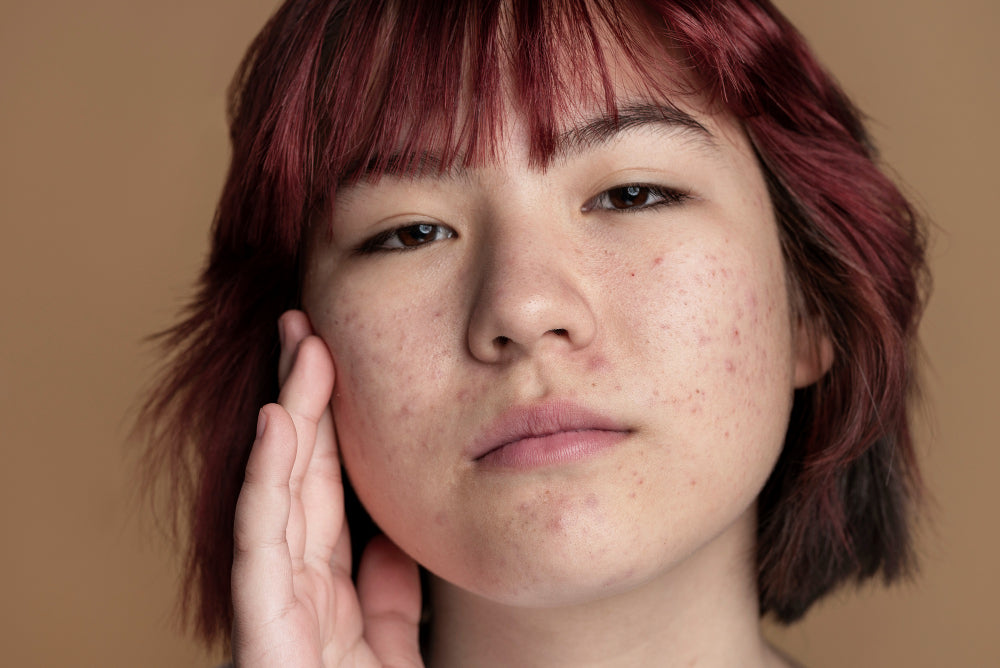Salicylic acid is one of the most popular ingredients in acne treatments, known for its ability to exfoliate the skin and unclog pores. If you've ever used a salicylic acid product and noticed your skin breaking out more than usual, you might have wondered, can salicylic acid cause acne?
Understanding the difference between purging, which is skin cell turnover triggered by salicylic acid, and a true breakout can help you navigate this common skincare concern.
What Is Salicylic Acid and How Does It Work?
Salicylic acid, a beta hydroxy acid (BHA), penetrates deep into the pores to dissolve excess oil, dead skin cells, and acne-causing debris. Unlike alpha hydroxy acids (AHAs), which primarily work on the skin's surface, salicylic acid is oil-soluble, allowing it to reach deep within the pores.
Key benefits of salicylic acid include:
-
Exfoliation: Helps shed dead skin cells to prevent clogged pores.
-
Anti-inflammatory properties: Helps calm redness and swelling caused by acne.
-
Oil control: Helps regulate sebum production, making it ideal for oily and acne-prone skin.
Can Salicylic Acid Cause Acne?
No, salicylic acid does not cause acne, but it can trigger purging. Purging occurs when the ingredient speeds up skin cell turnover, bringing clogged pores to the surface faster. This is a temporary phase and usually improves within 4-6 weeks. However, if breakouts persist beyond this period, they may be due to irritation or an unsuitable product.
What Is Skin Purging?
Purging occurs when active ingredients like salicylic acid increase the skin's cell turnover rate. This process brings underlying congestion (clogged pores, microcomedones) to the surface faster than usual. In other words, salicylic acid isn't causing new acne, it's simply revealing the breakouts already forming beneath the skin.
Does Salicylic Acid Cause Purging?

Yes, salicylic acid can cause purging. However, purging is different from a typical acne breakout in several ways:
|
Purging |
Breakout |
|
Occurs in areas where you usually get pimples |
Can appear in new areas where you don’t typically break out |
|
Pimples clear up faster than usual |
Pimples take longer to heal |
|
Happens after introducing a new active ingredient |
Can occur at any time, regardless of new products |
|
Improves with continued use |
May worsen with continued use if caused by irritation |
Purging typically lasts 2-3 weeks, depending on your skin type and the severity of existing congestion. During this time, being patient and avoiding introducing additional active ingredients that could further irritate your skin is crucial.
How to Tell If Salicylic Acid Is Causing Irritation
While purging is temporary, irritation indicates a product isn't suitable for your skin. Here are some warning signs of irritation:
-
Redness and inflammation that worsens over time
-
Excessive dryness and peeling
-
Breakouts in areas where you don't typically get acne
-
Burning or stinging sensation after application
If you experience these symptoms, reducing your usage may be best, or you may switch to a lower concentration of salicylic acid.
How to Minimize Purging and Breakouts When Using Salicylic Acid
If you're introducing salicylic acid into your routine, follow these tips to minimize excessive purging:
-
Start Slowly: Use salicylic acid 2-3 times per week before increasing frequency.
-
Use a Lower Concentration: Beginners should start with a product containing 0.5%–2% salicylic acid.
-
Moisturize: Hydrating your skin can reduce dryness and irritation.
-
Avoid Over-Exfoliation: Using multiple exfoliants simultaneously can lead to excessive peeling and sensitivity.
-
Wear Sunscreen: Salicylic acid increases your skin's sensitivity to the sun, making daily SPF essential.
Best Salicylic Acid Products for Acne-Prone Skin
If you're looking for a gentle yet effective salicylic acid product, consider these top-rated options:
From Cheeks Luxury Skin Clinic:
-
Lotion P50 (Biologique Recherche): A cult-favorite exfoliating toner with a blend of acids, including salicylic acid, to gently exfoliate and balance the skin.
-
Beta-Enzyme (MBR – Medical Beauty Research): An exfoliating gel infused with salicylic and azelaic acids to refine skin texture and promote clarity.
-
B-Active Sebuwash (Environ): A foaming face wash with tea tree oil and salicylic acid to help remove excess oil and impurities.
-
AlphaRet Clearing Serum (Skinbetter): A powerful serum combining salicylic acid with a retinoid to target acne and improve skin texture.
When to See a Dermatologist
If you've been using salicylic acid for over two months and are still experiencing persistent breakouts, it might be time to consult a dermatologist. They can assess whether you need a more potent prescription treatment or if another skin condition (such as fungal acne or rosacea) is causing your symptoms.
Final Verdict: Does Salicylic Acid Cause Acne?
Salicylic acid does not cause acne but can lead to temporary purging as it speeds up skin turnover. This phase can be frustrating, but it's usually a sign that the product works. To ensure success with salicylic acid, introduce it gradually, use it consistently, and monitor your skin for any signs of irritation.
If in doubt, consult a skin care professional for personalized advice. Book an appointment at Cheeks Luxury Skin Clinic today for expert guidance tailored to your skin’s needs. By understanding how salicylic acid works and what to expect when using it, you can make informed decisions about your skincare routine and achieve clearer, healthier skin in the long run.




